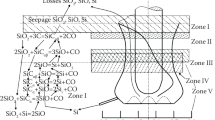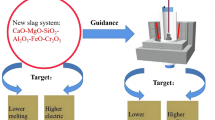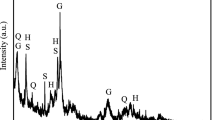Recycled scrap and waste are used in the production of copper and copper alloys. Cable scrap containing impurities of non-ferrous and ferrous metals is often used as copper scrap. Herein, we propose a novel steam-air oxidation method for the purification of copper alloys. In this method, the melt surface was blown with a steam-air mixture supplied to the melting furnace using a specially manufactured device. Technological parameters ensuring the effective removal of iron, tin, lead, and zinc impurities from the copper melt were determined experimentally. The melt oxidation degree, oxidizer consumption, and duration of the transition of impurities into slag and the gas phase were found to be the key parameters affecting the remelting refining of copper scrap. The technological parameters for the oxidation refining of the melt were optimized using the evolutionary solution search method in order to improve the efficiency of the process and reduce the deoxidizer consumption. It was found that to achieve the maximum efficiency of copper refining, it is necessary to ensure the optimal steam-air oxidation of the melt with oxygen dissolved in it. The results demonstrated the applicability of steam-air oxidation in the refining of copper scrap containing more than 1.6% impurities (including iron, tin, lead, and zinc) to obtain copper melts with chemical compositions corresponding to grades M0 and M1.


Similar content being viewed by others
Notes
According to GOST 859–2014, the contents of impurities (%) in M1 grade copper are 0.005 for iron; 0.005 for lead, 0.004 for zinc, 0.05 for oxygen, 0.002 for tin; and those in M0 grade are 0.004 for iron, 0.003 for lead, 0.003 for zinc, 0.05 for oxygen, 0.001 for tin.
References
Wasim S. Khan, Eilem Asmatulu, Md. Nizam Uddin, and R. Asmatulu, Recycling and Reuse of Engineering Materials: Recycling for Sustainable Development, Elsevier Inc. (2022); ISBN 978-0-12-822461-8; https://doi.org/10.1016/C2019-0-04547-5.
L. Li, G. Liu, D. Pan, V. Wang, Yu. Wu, and T. Zuo, “Review of technology for processing copper-containing cables,” Resour. Conserv. Proc., 132–140 (2017); https://doi.org/10.1016/j.resconrec.2017.07.024.
H. Barbakadze, V. Brostov, G. Granovsky, N. Gnatchuk, S. Lokhse, and A. T. Osmanson, “Separation of metal and plastic waste from the production of wires and cables for efficient processing,” Resour. Conserv. Proc., 139, 251–258 (2018); https://doi.org/10.1016/j.resconrec.2018.06.022.
H. Kumar, S. Kumagai, T. Kameda, Y. Saito, and T. Yoshioka, “Bench-scale PVC swelling and rod milling of waste wire harness for the recovery of Cu, PVC and plasticizers,” J. Mater. Cycles Waste Manag., 24, 12–23 (2022); https://doi.org/10.1007/s10163-021-01312-6.
H. Kumar, S. Kumagai, T. Kameda, Y. Saito, K. Takahashi, H. Hayashi, and T. Yoshioka, “Highly efficient recovery of high-purity Cu, PVC and phthalate plasticizer from waste wire harness by PVC swelling and rod milling,” React. Chem. Eng., 5(9), 1805–1813 (2020); https://doi.org/10.1039/D0RE00303D.
J. Xu, S. Kumagai, T. Kameda, Y. Saito, K. Takahashi, H. Hayashi, and T. Yoshioka, “Separation of copper and polyvinyl chloride from thin waste electrical cables: A combined PVC swelling and centrifugal approach,” Waste Manag., 89, 27–36 (2019); https://doi.org/10.1016/j.wasman.2019.03.049.
J. Lu, J. Xu, S. Kumagai, T. Kameda, Y. Saito, and T. Yoshioka, “Separation mechanism of polyvinyl chloride and copper components from swollen electric cables by mechanical agitation,” Waste Manag., 93(15), 54–62 (2019); https://doi.org/10.1016/j.wasman.2019.05.024.
J. Xu, N. Tazawa, S. Kumagai, T. Kameda, Y. Saito, and T. Yoshioka, “Simultaneous recovery of high-purity copper and polyvinyl chloride from thin electric cables by plasticizer extraction and ball milling,” RSC Achievements, 8(13), 6893–6903 (2018); https://doi.org/10.1039/C8RA00301G.
F. Pita and A. Castillo, “Separation of copper from electric cable waste based on mineral processing methods, a case study,” Minerals, 8(11), 517 (2018); https://doi.org/10.3390/min8110517.
Christie Pinheiro Bezerrade Araujo Mishene, Pinto Chavez Artur, Crocce Romano Espinosa Denise, and Alberto Soares Tenorio Jorge, “Electronic scraps – Recovering of valuable materials from parallel wire cables,” Waste Manag., 28(11), 2177–2182 (2008); https://doi.org/10.1016/j.wasman.2007.09.019.
Andrei Catinean, Lucian Dascalescu, Mihai Lungu, Laurentiu Marius Dumitran, and Adrian Samuila, “Improving the recovery of copper from electric cable waste derived from automotive industry by corona-electrostatic separation,” Part. Sci. Technol., 39(4), 449–456 (2021); https://doi.org/10.1080/02726351.2020.1756545.
M. Zabtotska-Malitska, P. Rutkowski, and V. Shchepanyak, “Recovery of copper from PVC multiwire cable waste by steam gasification,” Waste Manag., 46, 488–496 (2015); https://doi.org/10.1016/j.wasman.2015.08.001.
G. B. Krivtsova, A. N. Pimenov, and V. V. Petukhov, “Electrodynamic separation of non-ferrous metals prior to metallurgical processing in the field of high-frequency currents,” Metallurg, No. 8, 84–88 (2009).
Eduardo J. Tanabe, Roger M. Silva, Daliomar L. Oliveira Junior, and Daniel A. Bertwall, “Recovery of valuable metals from waste cables by employing mechanical processing followed by spouted bed elutriation,” Particuology, 45, 74–80 (2019); https://doi.org/10.1016/j.partic.2018.12.002.
T. R. Martins, N. S. Mrozinski, D. A. Bertuol, and E. H. Tanabe, “Recovery of copper and aluminum from coaxial cable wastes using comparative mechanical processes analysis,” Environ. Technol., 42, No. 20, 3205–3217 (2021); DOI: https://doi.org/10.1080/09593330.2020.1725141.
A. Salama, G. Richard, K. Medles, T. Zeghloul, and L. Dascalescu, “Distinct recovery of copper and aluminum from waste electric wires using a roll-type electrostatic separator,” Waste Manag., 76, 207–216 (2018); https://doi.org/10.1016/j.wasman.2018.03.036.
M. Saeki and A. Masumoto, “Electrostatic separation of chopped waste electric cables,” J. Environ. Eng., 2(2), 227–236 (2007); https://doi.org/10.1299/jee.2.227.
G. Richard, S. Touhami, T. Zeghloul, and L. Dascalescu, “Optimization of metals and plastics recovery from electric cable wastes using a plate-type electrostatic separator,” Waste Manag., 60, 112–122 (2017); https://doi.org/10.1016/j.wasman.2016.06.036.
Namil Um, Seon-Oh Park, Cheol-Woo Yoon, and Tae-Wan Jeon, “A pretreatment method for effective utilization of copper product manufacturing waste,” J. Environ. Chem. Eng., 9(4), 105509 (2021); https://doi.org/10.1016/).jece.2021.105509.
F. Lambert, S. Gaydardzhiev, G. Leonard, G. Lewis, P.-F. Bareel, and D. Bastin, “Copper leaching from waste electric cables by biohydrometallurgy,” Miner. Eng., 76, 38–46 (2015); https://doi.org/10.1016/j.mineng.2014.12.029.
V. A. Bryukvin, A. N. Zadiranov, V. G. Leontiev, and O. I. Tsybin, “Interaction of metallic copper melts with steam-air gas mixtures in relation to the tasks of the technology of their refining from impurities,” Tsvetn. Metally, No. 5, 34–36 (2003).
A. N. Zadiranov, Research, Development and Implementation of Technologies for Processing Nickel and Copper Technogenic Wastes to Obtain Finished Metal Products, PhD in Engineering thesis paper, Moscow (2004).
A. V. Kornilova, P. Tet, Z. Zhuo, A. I. Selishchev, and I. M. Idarmachev, Practical Guide to Processing of Experimental Data [in Russian], Ridero, Moscow (2018); ISBN 978-5-4493-8296-2.
Author information
Authors and Affiliations
Corresponding author
Additional information
Translated from Metallurg, Vol. 67, No. 3, pp. 101–107, March, 2023. Russian DOI: https://doi.org/10.52351/00260827_2023_03_101.
Rights and permissions
Springer Nature or its licensor (e.g. a society or other partner) holds exclusive rights to this article under a publishing agreement with the author(s) or other rightsholder(s); author self-archiving of the accepted manuscript version of this article is solely governed by the terms of such publishing agreement and applicable law.
About this article
Cite this article
Zadiranov, A.N., Meshcheryakov, A.V., Malkova, M.Y. et al. Improving the Efficiency of Refining Copper Scrap Melt Via Steam-Air Oxidation Based on Mathematical Modeling and Experimental Investigations. Metallurgist 67, 388–397 (2023). https://doi.org/10.1007/s11015-023-01525-0
Received:
Revised:
Accepted:
Published:
Issue Date:
DOI: https://doi.org/10.1007/s11015-023-01525-0




